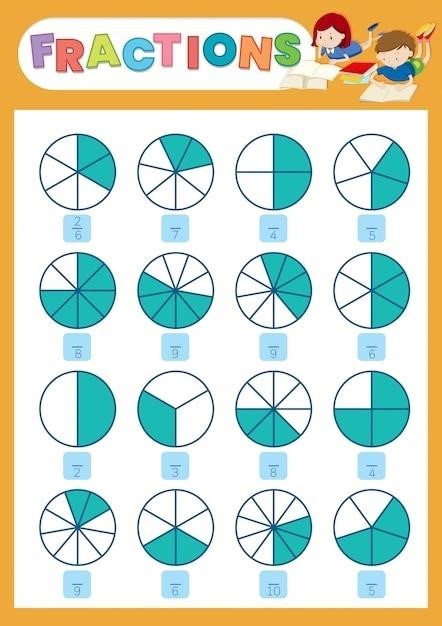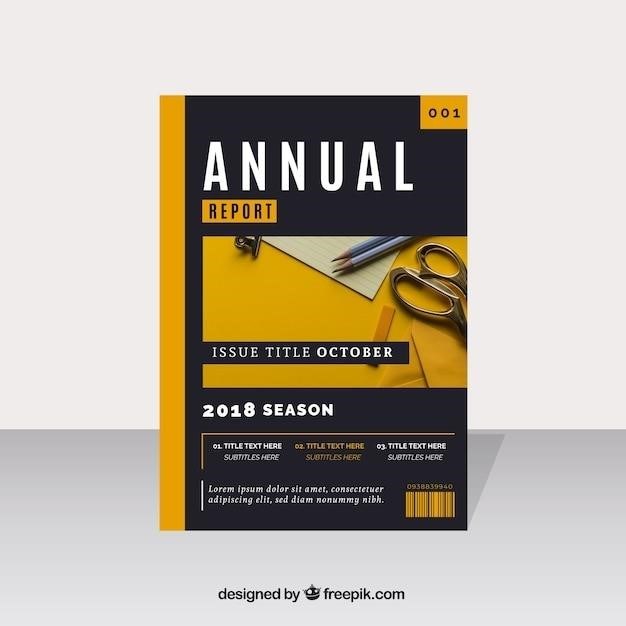Equivalent Fractions Worksheets⁚ A Comprehensive Guide
Equivalent fractions worksheets are valuable tools for students learning about fractions and their relationships. These printable worksheets offer a variety of exercises that help students understand and identify fractions that represent the same value, even though their numerators and denominators may differ. These worksheets are crucial for building a strong foundation in fraction concepts, which is essential for success in higher-level math skills.
What are Equivalent Fractions?
Equivalent fractions, also known as equal fractions, are fractions that represent the same proportion of a whole, even though they have different numerators and denominators. For example, 1/2, 2/4, and 4/8 are all equivalent fractions because they all represent half of a whole. The concept of equivalent fractions is crucial in understanding and manipulating fractions, as it forms the basis for more complex operations such as addition, subtraction, multiplication, and division of fractions.
Understanding equivalent fractions is essential for students to progress in their mathematical journey. Equivalent fractions help students grasp the concept of proportions and how different representations can still represent the same value. This understanding is fundamental for solving various mathematical problems, including those involving ratios, percentages, and measurement conversions.
Equivalent fractions can be visualized using various models, such as fraction bars, circles, or number lines. These visual aids help students understand the concept of equivalent fractions by showing how different parts of a whole can be divided to represent the same amount. For instance, a fraction bar divided into two equal parts with one part shaded represents 1/2, while a fraction bar divided into four equal parts with two parts shaded represents 2/4. Both representations visually depict the same amount, demonstrating the equivalence of the fractions.
Why are Equivalent Fractions Important?
Equivalent fractions play a crucial role in building a solid foundation in mathematics, extending beyond elementary concepts and influencing higher-level math skills. Mastering equivalent fractions is essential for success in various mathematical disciplines, including algebra, geometry, and calculus. In algebra, solving equations often involves finding common denominators and simplifying fractions, which require a strong understanding of equivalent fractions. Geometry utilizes equivalent fractions to compare shapes, sizes, and proportions, further emphasizing the importance of this concept.
The practical applications of equivalent fractions extend beyond academic settings and are relevant in everyday life. Understanding equivalent fractions is helpful in cooking, where recipes may need to be adjusted for different serving sizes. Financial literacy also benefits from this understanding, as it helps in comprehending interest rates and dividing bills effectively. Recognizing the practical applications of equivalent fractions can motivate students to engage more deeply with the subject matter and appreciate the relevance of what they are learning.
In summary, equivalent fractions are a cornerstone of mathematical understanding and have significant practical applications. Mastering equivalent fractions is essential for success in higher-level math and everyday life. By emphasizing the importance of these skills, educators can help students build a strong mathematical foundation that will benefit them both academically and in real-world scenarios.
Types of Equivalent Fractions Worksheets
Equivalent fractions worksheets encompass a variety of exercises designed to cater to different learning styles and skill levels. These worksheets can be categorized based on their focus and complexity, offering a comprehensive approach to mastering the concept of equivalent fractions.
One common type of worksheet focuses on identifying equivalent fractions through visual aids. These worksheets typically use fraction bars, circles, or other shapes divided into equal parts. Students are asked to shade in portions of these shapes to represent different fractions and then identify which fractions are equivalent. This visual approach helps students develop a concrete understanding of the concept of equivalent fractions.
Another type of worksheet focuses on finding equivalent fractions through multiplication or division. Students are given a fraction and asked to find an equivalent fraction by multiplying or dividing both the numerator and denominator by the same number. These worksheets help students develop a more abstract understanding of equivalent fractions and how to manipulate them.
Word problem worksheets are also common. These worksheets present real-world scenarios that require students to apply their understanding of equivalent fractions to solve problems. These problems can range in complexity and help students see the practical application of equivalent fractions.
Equivalent Fractions Worksheets for Different Grade Levels
Equivalent fractions worksheets are tailored to different grade levels, ensuring that students encounter appropriate challenges and concepts as they progress through their mathematical journey. These worksheets are designed to build upon prior knowledge and introduce new concepts in a gradual and engaging manner.

For younger students, such as those in the third or fourth grade, worksheets often focus on basic equivalent fractions with simpler denominators like 2, 4, 8, and 10. They may involve visual aids like fraction bars or circles to help students visualize the concept of equivalent fractions. These worksheets may also include simple word problems to introduce real-world applications of equivalent fractions.
As students advance to higher grades, the worksheets become more complex. Fifth and sixth-grade worksheets may include larger denominators, more complex word problems, and the introduction of simplifying fractions. Students may also be introduced to the concept of finding equivalent fractions using multiplication and division.
For older students, worksheets might focus on more advanced concepts like finding the least common multiple (LCM) and using equivalent fractions to solve algebraic equations. The worksheets may also include more challenging word problems that require students to analyze and apply their knowledge of equivalent fractions to real-world scenarios.
Visual Aids in Equivalent Fractions Worksheets
Visual aids play a crucial role in making the abstract concept of equivalent fractions more concrete and accessible for students. Equivalent fractions worksheets often incorporate a variety of visual aids to help students understand the relationship between different fractions that represent the same value.
One common visual aid is the use of fraction bars or circles. These diagrams are divided into equal parts, representing the denominator of a fraction. Students can then shade in a portion of the bar or circle to represent the numerator. By comparing different fraction bars or circles with the same total number of parts, students can visually see how different fractions can be equivalent.
Another visual aid used in equivalent fractions worksheets is the use of number lines. Number lines are a helpful tool for visualizing fractions and their relationships. Students can mark different fractions on a number line and see how they correspond to each other. For example, they can see that 1/2 is equivalent to 2/4 and 4/8 because they all occupy the same position on the number line.
These visual aids help to reinforce the concept of equivalent fractions by providing students with a concrete representation of the abstract concept. They can help to make the learning process more engaging and enjoyable for students, making it easier for them to grasp the concept of equivalent fractions.
Real-Life Applications of Equivalent Fractions
While equivalent fractions may seem like an abstract mathematical concept, they have numerous practical applications in everyday life. Understanding equivalent fractions can help students navigate various real-world scenarios and make informed decisions.
One common application is in cooking. Recipes often require adjusting the quantities of ingredients based on the number of servings. Knowing how to find equivalent fractions can help students adjust recipes proportionally, ensuring that the final dish tastes as intended. For example, if a recipe calls for 1/2 cup of flour for 4 servings, but you want to make 8 servings, you can use the concept of equivalent fractions to determine that you need 1 cup of flour.
Equivalent fractions are also useful in financial literacy. Understanding interest rates and dividing bills requires a grasp of equivalent fractions. For instance, when calculating interest on a loan, it is necessary to understand how different interest rates can be represented as equivalent fractions, allowing for accurate comparisons. Similarly, when splitting a bill evenly among friends, knowing how to find equivalent fractions can help ensure that everyone pays their fair share.
By highlighting these real-world applications, teachers can help students see the relevance of equivalent fractions and motivate them to engage more deeply with the subject matter.
How to Use Equivalent Fractions Worksheets Effectively
Equivalent fractions worksheets can be a valuable tool for reinforcing the concept of equivalent fractions and helping students develop a deeper understanding. To use these worksheets effectively, teachers should consider the following strategies⁚
Firstly, it’s essential to introduce the concept of equivalent fractions clearly and with visual aids. Fraction bars, circles, or other representations can help students visualize how different fractions can represent the same portion of a whole. Once the concept is introduced, the worksheets can be used for practice and reinforcement.
Secondly, it’s important to start with simple exercises and gradually increase the complexity. Begin with basic equivalent fractions involving small denominators and gradually introduce larger denominators and more challenging problems. This gradual approach ensures that students build a solid foundation before tackling more complex concepts.
Thirdly, encourage students to use different methods for finding equivalent fractions. For example, they can use multiplication, division, or visual aids like fraction bars or circles. Allowing students to explore different methods can help them develop a deeper understanding of the concept and find strategies that work best for them.
Finally, make sure to provide feedback and support to students as they work through the worksheets. Review their work, clarify any misconceptions, and encourage them to ask questions. Providing regular feedback can help students identify areas where they need more practice and ensure that they are progressing effectively.
Benefits of Using Equivalent Fractions Worksheets
Equivalent fractions worksheets offer a multitude of benefits for students learning about fractions. These worksheets provide a structured and engaging way to reinforce the concept of equivalent fractions, leading to a deeper understanding and greater proficiency. Here are some of the key benefits⁚
Firstly, these worksheets provide ample practice opportunities. The repetitive nature of the exercises helps students solidify their understanding of equivalent fractions and develop fluency in identifying and manipulating them. This practice is crucial for building a strong foundation in fraction concepts, which is essential for success in higher-level math.
Secondly, equivalent fractions worksheets can help students develop visual reasoning skills. Many worksheets incorporate visual aids like fraction bars or circles, which help students visualize how different fractions can represent the same portion of a whole. This visual representation can make abstract concepts more concrete and accessible to students, particularly visual learners.
Thirdly, these worksheets can help students develop problem-solving skills. By working through various problems involving equivalent fractions, students learn to apply their knowledge to different scenarios and develop strategies for solving problems. This skill is essential for success in all areas of mathematics and beyond.
Finally, equivalent fractions worksheets can help students build confidence in their mathematical abilities. The structured practice and positive reinforcement provided by these worksheets can help students overcome their anxieties about fractions and develop a more positive attitude towards mathematics.
Where to Find Free Equivalent Fractions Worksheets
There are a wealth of free resources available online for educators and parents seeking equivalent fractions worksheets. These resources provide a convenient and cost-effective way to access high-quality worksheets that can be used for classroom instruction, homework assignments, or extra practice. Here are some of the best places to find free equivalent fractions worksheets⁚
One excellent resource is Richland One. This website offers a variety of printable worksheets covering different aspects of equivalent fractions, including exercises with denominators of 10 and 100, real-life word problems, and visual aids. Another valuable resource is K5 Learning, which provides free printable worksheets for various grade levels, focusing on completing equivalent fractions.
Finally, SunCatcherStudio.com offers a variety of free printable equivalent fractions worksheets in both PDF and PNG formats. These worksheets include a range of exercises, from basic introductions to more challenging problems, making them suitable for a variety of learning levels.
Tips for Creating Your Own Equivalent Fractions Worksheets
Creating your own equivalent fractions worksheets can be a rewarding experience, allowing you to tailor the content to your students’ specific needs and learning styles. Here are some tips for crafting effective and engaging worksheets⁚
Start by identifying the specific learning objectives you want to address. Are you focusing on basic understanding of equivalent fractions, simplifying fractions, or finding missing numerators or denominators? Once you have clear goals, you can design exercises that directly target those objectives.
Incorporate a variety of question types to keep students engaged and challenged. Use visual aids, such as fraction bars or circles, to help students visualize the concept of equivalent fractions. Include word problems to apply the concepts in real-world scenarios. Remember to gradually increase the difficulty of the exercises as students progress.
Consider using technology to create your worksheets. Online tools and software can help you design visually appealing and interactive worksheets that can be easily printed or shared digitally. You can also use these tools to create answer keys, making it easier for you to check students’ work.
Don’t forget to provide clear instructions and examples to guide students through the exercises. You can also include a space for students to show their work, encouraging them to demonstrate their understanding of the concepts.
Finally, remember to make the process fun and engaging for students. Use colorful visuals, interesting scenarios, and positive reinforcement to encourage their learning and build confidence in their understanding of equivalent fractions.
Equivalent Fractions Worksheets in the Digital Age
The digital age has revolutionized the way we create, share, and utilize educational resources, including equivalent fractions worksheets. The internet offers a wealth of interactive and engaging online platforms that cater to various learning styles and provide a dynamic learning experience.
Interactive websites and online learning platforms offer dynamic equivalent fractions worksheets that go beyond static printouts. These digital worksheets often feature interactive elements, such as drag-and-drop activities, animated visuals, and self-grading features. This interactive approach can make learning more engaging and provide immediate feedback to students, fostering self-directed learning and reinforcing understanding.
Digital equivalent fractions worksheets also offer flexibility and accessibility. Students can access these resources from any device with an internet connection, making learning convenient and adaptable to individual schedules. Teachers can easily share digital worksheets with their students, eliminating the need for printing and paper distribution.
Furthermore, digital platforms often provide a wide range of customization options. Teachers can adjust the difficulty level, personalize the content, and even track student progress through interactive features. This level of customization allows for targeted instruction and ensures that students are challenged at an appropriate level.
The digital age has opened up a world of possibilities for equivalent fractions worksheets, making them more engaging, accessible, and adaptable to the needs of both students and educators.


